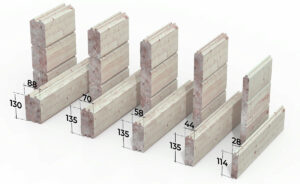When you set out to build your wooden cabin, it’s important to know and understand U-values. In this guide, you’ll learn all the basics you need to know. You’ll also find all the U-values for Casetas de Jardin cabin components listed in helpful tables.
Table of contents:
The temperature resistance of wooden houses, like log cabins and garden houses, is measured in U-values. There’s one simple rule: the lower the U value, the better. A lower number means the cabin has more resistance to outdoor temperatures and the inside climate is more even.
Wooden buildings with lower U-values will stay warmer during the colder months and cooler during the hot summer. This, in turn, means less money spent on heating and cooling, thanks to reduced energy costs.
The key points to remember are:
Lower numbers = Better insulation
Higher numbers = More heat loss (winter) or gain (summer)
In order for you to understand how to reach a desired level of weather resistance and how to improve different areas of the cabin, it’s important to consider all parts of the building.
In this guide, we will provide the U-values of all Casetas de Jardin wooden cabin components:
If you’re looking to build a garden room or log cabin for year-round use, you need to make sure that all cabin parts are considered. For example, if your cabin has energy-efficient windows that are double-glazed and insulated (low U-value), but the cabin roof is not insulated (high U-value), the sun will warm up the cabin quickly, making the structure less weather resistant.
Or, for example, when you have an insulated roof coupled with double-glazed doors and windows (low U-value), but the walls are too thin (high U-value), you will have the same problem.
U-values are also used in building regulations. If you plan to build a cabin for public, commercial or residential use, you may need to meet certain requirements. By providing the U-values given below, you can easily choose the correct windows, walls, and insulation kits to meet the necessary requirements.

Thicker walls generally provide better insulation. If you find that 44mm walls don’t meet your needs, upgrading to 70mm or 88mm construction provides significantly better thermal performance.
| Wall thickness | U-value |
|---|---|
| 21mm wall | 2.93 W/m²·K |
| 28mm wall | 2.53 W/m²·K |
| 44mm wall | 1.93 W/m²·K |
| 70mm wall | 1.39 W/m²·K |
| 88mm wall | 1.17 W/m²·K |
Sometimes, adding dedicated insulation materials can be more cost-effective than simply increasing timber thickness. Don’t hesitate to ask our sales team for advice on your project. Keep in mind that poor installation can significantly affect performance. Proper fitting and sealing are highly important to achieve the desired U-values.
| Insulation | U-value |
|---|---|
| Floor and roof: Insulation boards 30mm |
Approximate U-value: 0.741 W/m²·K |
| Walls: Rockwool Superrock Premium 100mm |
U-value: 0.345 W/m²·K |
The approximate U-values of our timber cabins insulated with 100mm Superrock Premium rockwool are listed below:
| Insulated walls | Approximate U-value |
|---|---|
| 44mm solid timber wall & 100mm rockwool | 0.276 W/m²·K (reduced from 1.39) |
| 70mm solid timber wall & 100mm rockwool | 0.293 W/m²·K (reduced from 1.93) |
| 88mm glulam timber wall & 100mm rockwool | 0.266 W/m²·K (reduced from 1.17) |
Here’s what you can expect when you choose our floor insulation:
| Insulated floors | U-value |
|---|---|
| 21 mm floor board & 30 mm insulation board | 0.591 W/m²·K (reduced from 2.93) |
| 28 mm floor board & 30 mm insulation board | 0.573 W/m²·K (reduced from 2.53) |
Quality glazing makes a real difference to comfort. Poor windows create drafts and cold spots, which is why we use double-glazed units as standard, even on smaller cabins.
| Glass type | U-value |
|---|---|
| Standard glass package | 3.0 W/m²·K |
| Argon-filled glass package | 2.8 W/m²·K |
| Selective glass with argon | 1.6 W/m²·K |
| Orthez standard double glazing (tempered) | 2.6 W/m²·K |
| Orthez double glazing with argon (tempered) | 1.1 W/m²·K |
We also recommend using window and door insulation kits to prevent thermal bridges around openings. Our ISO kit uses breathable materials that won’t trap moisture and can accommodate the natural movement of timber buildings during their first 1-2 years.
Choosing the right combination of wall thickness, insulation, and glazing depends on your specific needs, budget, and intended use. Our sales team can help you work through the options and ensure you get the performance level you need while staying within your budget.